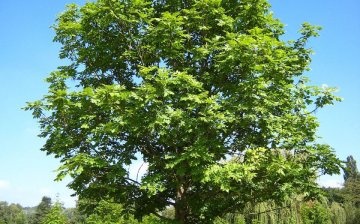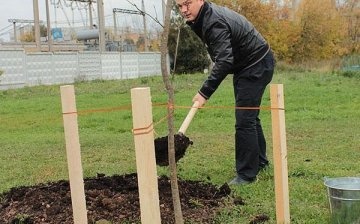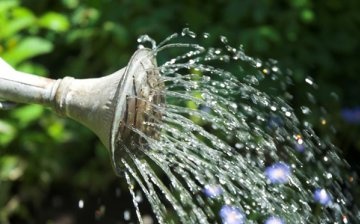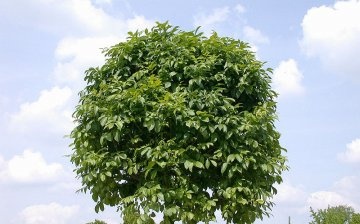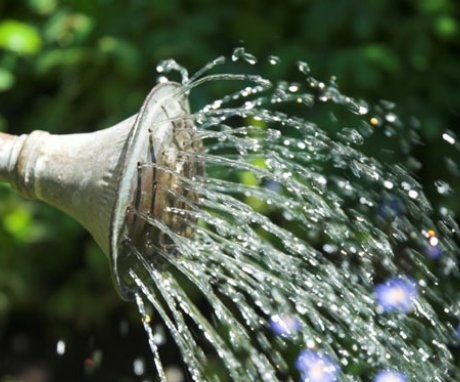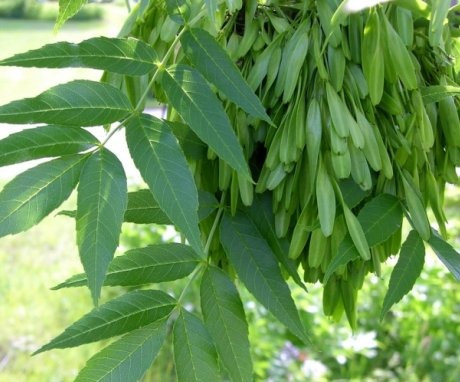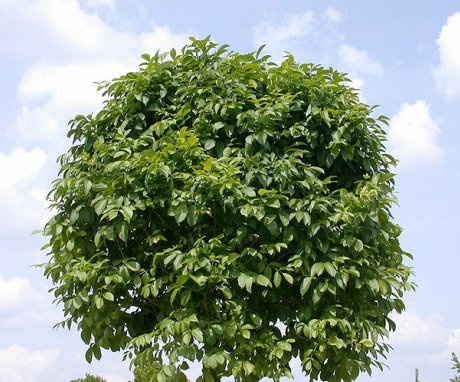Ash - what kind of tree is it?
In many countries ash used as an ornamental plant. It has minimal maintenance and watering requirements. Its main feature is serious pests that settle inside the wood. But if you plant a plant correctly, care for it and control its growth, any ailment can be prevented.
Content:
- Description and the best varieties for growing
- Landing: timing and rules
- Care Tips
- Diseases and pests
- Application in landscape design
Description and the best varieties for growing
Ash is a fairly common plant. It is distinguished by various species that grow all over the world. Ash is used as an ornamental plant for a personal plot, and its wood is also used on the farm. The tree comes from the Dicotyledonous class and is a member of the Olive family. The ash tree has more than one root, it has branched rhizomes, stretching over vast territories, while releasing many young basal seedlings.
The bark is gray with an ash tint. From above, the entire trunk is smooth, pleasant to the touch, going down closer to the base of the root, it acquires age-related cracks of a brown tint. Ash grows as a huge tree - its trunk diameter is 1 meter. The branches form a luxurious bright green ball-shaped crown. During growth, almost all shoots take on an arched structure, stretching upward.
The average height of a plant is 20-35 meters; in wildlife, trees can stretch up to 60 meters up.
The inflorescences of the tree are represented by small panicles. They can be of different shades - burgundy, white, purple. The plant is bisexual, but flowers of different sexes bloom at different times, so there is a danger of not getting fertilized seeds.
In wildlife, a large number of varieties are distinguished. All of them are highly resistant to drought, not susceptible to severe frosts. The most famous of them are distinguished:
- Ordinary - grows up to 30 m, the crown of the tree is high, takes on an openwork shape. Grows well on slightly alkaline soils. It can be seen in the Caucasus, Iran, Transcaucasia.
- Floral (white) - the crown is low. The tree takes the form of a pubescent ball. The plant grows no more than 20 m. Turkey is considered its homeland, but can also be found in Australia, Western Siberia, Spain, and South Bohemia.
- American - a tall tree reaches 40 m, takes on the appearance of a slightly elongated ovoid. Young leaves and petioles are covered with a little fluff, with age, the softness disappears.
- Lanceolate (green) - a small tree up to 15 m. The branches are strongly raised, well fluffed in different directions, which form a light, well-ventilated ball shape. Withstands up to -45 C. Negatively refers to trimmings of any type.
- Narrow-leaved. The crown of the tree is wide, oval, and dense. Used as a decoration for home gardens in America and Southern Europe.
- Fluffy - stretches up to 20 m, opening up with spreading branches of an untidy shape, which can take up to 12-13 m in diameter. Long-liver - can live more than 350 years.
- Manchurian - the diameter of its main trunk reaches 1.5 m, it stretches in height to 30-35 m, the crown is raised high above the ground, with a beautiful openwork structure.
- Black - grows well in swampy areas, as well as on the coast of rivers and lakes. Differs in almost black wood color.
Thus, ash not only has a large number of different types and types, but is also scattered around the globe. Trees differ in various categories - from crown shape to bark shade.
Landing: timing and rules
Planting an ash tree on your site will not be difficult. To grow it, you will need to fulfill several requirements:
- The land should be fertile, loose, well permeable to moisture and air necessary for root system... It is desirable that the substrate is well drained.
- It is best to choose a soil substrate with neutral or slightly acidic neutrality. Strongly acidic and overly alkaline soils are categorically unsuitable for ash. In such soils, its root system will not develop, which will cause the death of the plant.
- The site for placement should be chosen sunny, without shading by other tall trees.
Before planting, the soil should be fertilized with calcium. But before you deposit mineral fertilizers the soil should be well moistened, but not brought to a marshy state. Prepare the soil 2-3 months before the planned event. This is necessary so that the soil is saturated with micronutrients. The optimal timing for planting young seedlings is the beginning of the autumn months. When choosing ash seedlings, you should carefully consider the planting material.
The cuttings should have a healthy appearance, the bark should be free of unnecessary cracks, outgrowths or other unusual qualities, the trunk should be even and straight. The root of the future tree should have elastic roots and a light branched root system.
Landing rules:
- When planting, a recess is dug 3 times larger than the earthen lump of the selected seedling.
- Drainage is poured on the bottom of the pit. It can be poured with pebbles, broken brick or expanded clay. Pour in such an amount of drainage so that it fills the hole by 1/4 of the total volume.
- A layer of humus or manure is laid out on top of the drainage.
- After that, soil is poured 10-15 cm. Only then is a clod of earth with the root system of the seedling placed. If there is no soil on the roots, then the latter should be carefully leveled and sprinkled with earth.
Planting a seedling with a clod of earth is recommended to rise 5-15 cm above the main soil. When the soil settles, the root collar will move to the level required for successful growth and rapid development.
Care Tips
For the rapid growth and growth of the crown, you should know some of the nuances of its cultivation. If you follow simple rules, then after a few years you can admire a beautiful tree.
Ash prefers abundant wateringbut if it can be seen that the land no longer absorbs the supplied moisture, then the irrigation should be completed.
Excessive flooding of life-giving water is required only during hot summers and severe drought. The main thing is that you cannot water in the middle of the day, during the midday sun rays. They can provoke burns on the leaves through droplets of water falling on the surface of the greenery. The same effect is achieved when watering in a strong wind.
When planting a young tree in the recess, the pits are laid out organic fertilizers... They are enough for a maximum of 2 years. After this period, top dressing should be applied every autumn and spring:
- Spring - a solution of urea (15 g), manure (2 kg), calcium nitrate (25 g) and ammonium nitrate (25 g), diluted in 10 liters of water (bucket).
- Autumn - nitroammofoska, in a volume of 20 g, diluted in 20 liters of water.
Although ash does not like pruning, it should still be done in the spring. The procedure is carried out until the moment of budding. Sanitary and formative pruning is performed.All branches that were broken during the autumn-winter period, mechanically damaged, dried up on their own or were beaten by pests or diseases are subject to removal.
In addition, a crown is formed - the stem is cut to a level above the ground of 3 meters. After that, a cut is made of all weak and thin branches. Thus, it provides full care of the tree. Ash is not a capricious plant, so it will live well without pruning, as well as watering (if it gets to groundwater).
Diseases and pests
All problems leading to diseases and pests come from improper care and control over the condition of the plant. Most often, ash is affected by the following diseases:
- Cytophomous cancer - if a tree is placed in swampy areas with high humidity, the plant is affected by a fungal disease. Wood suffers from it. We have to cut down diseased trees and burn them in an accelerated manner so that they do not have time to infect other specimens.
- Infectious necrosis is a disease provoked by a fungus. With it, whole strips of bark die off in large areas. Spraying in the spring with iron sulfate (3%), application bordeaux liquid during the growing season (1% solution), top dressing.
- White butt rot, finely cracked in nature - cannot be detected without cutting the plant. Affects the core and root system. The interior is rapidly deteriorating, turning into dust. It gets into wood through cracks and scratches. It provokes a disease - a fungus. Fighting - covering with garden varnish, monitoring the condition of the bark, pruning rotten areas to a healthy area.
In addition, ash trees are very fond of settling various pests - the ash-colored bast beetle, a narrow-bodied emerald goldfish. They settle in the bark or in the center of the tree. It is very problematic to spot parasites. It is recommended to use from bark beetle insecticides at the moments when this parasitic beetle's years are planned. You should also attract birds that feed on this type of pest.
When a goldfish appears, you should pick out the passages of the parasite and introduce a tampon saturated with a solution of hexachlorane. Only after that, the recess must be covered with clay or cement. It will not be superfluous to sprinkle young and plantations at the age of 3% with the essence of chlorophos. The procedure must be performed in late spring - early summer.
Thus, if you follow the ash, you can replace the appearance of diseases or pests in the early stages of identifying symptoms. Immediately take the necessary control measures and save the plant from significant pruning or complete death.
Application in landscape design
Ash a lot of things to use. It is not only suitable for landscaping for decorative purposes of its own plot next to the house, but also for the production of wooden furniture, for protective and reclamation afforestation.
For use as a decor, ash trees are planted in park areas or on viewing platforms. It perfectly tolerates polluted air saturated with exhaust gases and vapors. Therefore, it is recommended to grow it near roads, for fencing city gardens or parks.
The main advantages of a plant for use in design are ease of care and minimal requirements for placement.
Different varieties are used for planting in the alleys. Lanceolate or regular ash looks good. In addition, they look good when placed next to small bodies of water.
In a single planting, American ash looks interesting. For large-scale mixing of different varieties of trees, a narrow-leaved variety is suitable. It is worth noting the quality of ash wood. It is appreciated for its elasticity, flexibility and original color scheme. The black ash variety stands out especially.
More information can be found in the video:



